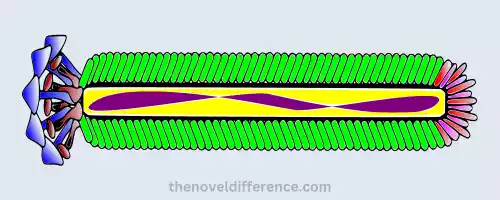Overview of Lambda phage and M13 phage
Lambda Phage:
Lambda Phage, also known by the name bacteriophage Lambda, infects Escherichia Coli (E. coli) bacteria. It belongs to the family Siphoviridae and is one of the most extensively studied phages. Lambda phage exhibits a complex life cycle, which involves both a lysogenic phase and a lytic phase.
In the lysogenic cycle, the lambda phage integrates its DNA into the bacterial chromosome, becoming a prophage. The integrated DNA called the lambda prophage, is then replicated along with the bacterial DNA during cell division.
The bacterial host cell continues to grow and divide without producing new phage particles. However, under certain environmental conditions or stressors, the lambda phage can enter the lytic cycle.
During the lytic cycle, the lambda phage initiates the production of viral proteins and enzymes that lead to the lysis of the bacterial host cell. The replicated phage DNA is packaged into new phage particles, which are released upon cell lysis and can go on to infect new bacterial cells.
M13 Phage:
M13 phage, also known as filamentous phage M13, is a single-stranded DNA bacteriophage that infects E. coli bacteria. It belongs to the family Inoviridae and has a unique filamentous shape. Unlike lambda phage, M13 phage exclusively undergoes a replicative cycle and does not enter a lysogenic phase.
During the replicative cycle, the M13 phage attaches to specific receptors on the E. coli cell surface and injects its single-stranded DNA into the host cell. The phage DNA is then converted into a double-stranded form and serves as a template for the production of new phage DNA strands.
The newly synthesized phage DNA is extruded through the host cell membrane, which does not result in host cell lysis. Instead, the released phage particles can infect neighboring bacteria without causing cell death.
Applications of M13 phage:
M13 phage has found extensive applications in various research fields. One notable application is the phage display technology, where foreign peptides or proteins can be genetically fused to a coat protein of M13 phage.
This allows the displayed peptides or proteins to be screened for specific binding interactions, enabling the discovery of new drugs, antibodies, and biomolecules.
Additionally, the M13 phage has been widely used in genetic engineering and biotechnology. Its ability to carry foreign DNA inserts, such as genes or regulatory elements, has facilitated the development of gene libraries and the production of recombinant proteins. M13-based vectors have become valuable tools for cloning, DNA sequencing, and protein expression studies.
Definition of bacteriophages
Bacteriophages are viruses that infect bacteria and multiply within them. The term bacteriophage derives its meaning from two Greek words, “Bacteria” meaning bacteria and “Phagen”, meaning to devour or digest. Bacteriophages are highly specific in their ability to infect and replicate within certain bacterial species or strains.
Bacteriophages have a complex structure consisting of a protein coat or capsid that encapsulates their genetic material. Gene materials vary based on which page it belongs to and could include either double-stranded or single-stranded copies, depending on their purpose.
The protein coat helps protect the phage’s genetic material and facilitates the attachment to specific receptor sites on the bacterial cell surface.
The life cycle of a bacteriophage can follow either a lytic cycle or a lysogenic cycle. In the lytic cycle, the phage infects the bacterial cell, hijacks its machinery to produce more phage particles, and ultimately causes the lysis or bursting of the host cell, releasing new phage particles to infect neighboring bacteria. This cycle results in the destruction of the infected bacterial population.
In the lysogenic cycle, some bacteriophages integrate their genetic material into the bacterial chromosome, becoming a prophage. The prophage is replicated along with the bacterial DNA during cell division and can remain dormant within the host cell for an extended period.
Under certain conditions, such as environmental stress or changes, the prophage can exit the lysogenic state and enter the lytic cycle, leading to the production of new phage particles and the lysis of the host cell.
Bacteriophages play an integral part in bacterial ecology and evolution, contributing to genetic diversity through horizontal gene transfer between populations of bacteria.
They can transfer genes encoding antibiotic resistance, virulence factors, and other advantageous traits, impacting bacterial pathogenesis and adaptation to changing environments.
Due to their unique ability to specifically target and infect bacteria, bacteriophages have attracted attention for their potential applications in phage therapy, which involves using phages to combat bacterial infections.
Examining Bacteroid Phages Is Essential
Studies of bacteriophages can be of enormous value due to multiple reasons, including:
Understanding bacterial Infections: By studying bacteriophages we can gain greater insights into bacterial infections’ dynamics as well as mechanisms by which these infectious agents infiltrate bacteria populations and how they influence these communities, providing valuable knowledge that could assist us in devising ways to combat infections that threaten public health and ultimately enhance human lives.
Phage Therapy: By studying phages and their potential use as therapeutic agents against various bacteria strains, researchers may develop innovative therapeutic applications – or “phage therapies”, using specific phages to target and kill pathogenic pathogens while sparing beneficial ones from harm.
Studying these bacteriophages enables scientists to discover more effective phages against specific bacterial strains as well as understand their mechanisms of action and optimize therapeutic applications.
Antibiotic Resistance Crisis: Antibiotic-resistant bacteria have become a global health crisis. Bacteriophages offer one possible strategy or supplementation approach for combatting these infections by targeting and killing antibiotic-resistant organisms while mitigating resistance gene spread, or creating treatments utilizing these phages that overcome antibiotic resistance altogether.
Genetic Tools and Biotechnology: Bacteriophages have proven invaluable as tools in molecular biology and genetic engineering, serving as vectors to transport foreign DNA into bacteria cells for gene transfer or recombinant DNA technology applications.
Furthermore, studying these phages enables scientists to create innovative phage-based genetic tools and systems used for applications spanning gene expression studies, protein production, DNA sequencing as well as system development projects.
Evolution and Horizontal Gene Transfer: Bacteriophages have an enormous influence on bacterial evolution through horizontal gene transfer.
By transference between different bacteria species, these viruses help spread beneficial traits, such as antibiotic resistance or virulence factors, among them beneficial traits that arise as antibiotic resistance or other beneficial traits such as increased resistance against viruses such as influenza A or influenza B virus infections.
By studying them we gain an insight into these processes as well as monitoring for any emerging and spreading antibiotic resistance genes that arise or gain widespread dissemination over time.
Studying bacteriophages provides invaluable knowledge of their interactions between bacteria and viruses – which has important ramifications for health, disease treatment, and understanding complex ecosystems such as microbiomes.
Lambda Phage
Lambda phage, also known as bacteriophage lambda, is a temperate bacteriophage that infects Escherichia coli (E. coli) bacteria. It is one of the most extensively studied phages and has played a crucial role in advancing our understanding of molecular biology and genetics.
Lambda phage belongs to the family Siphoviridae and has a complex genetic structure and life cycle. It has a linear double-stranded DNA genome that is approximately 48.5 kilobase pairs in size.
The genome is enclosed within a protein capsid or head, and a long noncontractile tail extends from the capsid. The tail attaches to specific receptor sites on the surface of E. coli cells, allowing the phage to infect and enter the host cell.
The life cycle of lambda phage involves both a lysogenic phase and a lytic phase, providing it with a unique ability to switch between these two states.

- Lysogenic cycle: In the lysogenic cycle, lambda phage integrates its DNA into the bacterial chromosome, becoming a prophage. The integration is mediated by site-specific recombination between the phage DNA and the bacterial DNA. The integrated phage DNA is usually inserted into a specific site on the E.coli chromosome called the attB site. Once integrated, the phage DNA is replicated along with the bacterial DNA during cell division, allowing the prophage to be stably inherited by the bacterial cell and its descendants.
The lysogenic state is characterized by the absence of phage replication and the absence of host cell lysis. The bacterial host cell continues to grow and divide normally, with the prophage being maintained within its genome.
However, under certain environmental conditions or stressors, such as DNA damage or changes in nutrient availability, the prophage can be induced to enter the lytic cycle.
- Lytic cycle: In the lytic cycle, lambda phage undergoes active replication and ultimately causes the lysis or bursting of the host bacterial cell. The induction of the lytic cycle is triggered by the expression of specific lambda genes, often regulated by the activity of the bacterial SOS response system.
Once induced, lambda phage initiates the production of viral proteins and enzymes that lead to the replication of phage DNA, the synthesis of new phage particles, and the degradation of the host cell’s DNA. The replicated phage DNA is packaged into new phage particles, which assemble and accumulate within the host cell.
Eventually, the host cell lyses, releasing a large number of phage particles that can go on to infect new bacterial cells and repeat the cycle.
The ability of lambda phage to switch between the lysogenic and lytic cycles provides it with distinct advantages. In the lysogenic state, the phage can remain dormant within the bacterial population, ensuring its persistence and inheritance.
In contrast, the lytic cycle allows for the efficient production and release of phage particles, enabling the spread of the phage to new host cells.
The study of lambda phage has significantly contributed to our understanding of gene regulation, DNA recombination, and the molecular mechanisms of viral replication.
Lambda phage and its unique life cycle have served as model systems for numerous experiments and have provided fundamental insights into the field of molecular biology.
M13 Phage
M13 phage (also referred to as filamentous phage M13) is a bacteriophage that infects Escherichia coli (E. coli).
As part of its family of Inoviridae viruses, M13 belongs to its filamentous shape with approximately 900-nanometer length and 6-6-7 nanometer width, belonging to the Inoviridae virus subfamily Inoviridae family bacteriophages; hence making them valuable tools in molecular biology and biotechnology research.
M13phage has become widely studied since its discovery; becoming an invaluable tool in molecular biology research as a toolkit in molecular biology research environments a toolkit in molecular biology research settings as a valuable biotech toolkit in molecular biology research environments as a toolkit in biotechnology research applications due to extensive studies done over its many variants!

Here are a few key features and characteristics of the M13 phage:
M13 phage possessing a circular single-stranded DNA genome measuring around 6.44kilobase pairs contains genes for essential proteins related to replication, assembly, and infection of host cells.
Replicative Life Cycle: In contrast with many other phages, M13 does not follow a typical lytic lifecycle but instead undergoes a replicative one upon invading E. coli cells; upon infection, they attach to specific receptors on its surface before injecting their single-stranded DNA genome directly into its host cell’s cytoplasm and become replicating once inside it.
Once inside a host cell, single-stranded DNA serves as an initiating template for producing its complementary strand, leading to double-stranded replication of itself and multiple copies being generated via rolling circle replication.
From there it passes out of its host cell without inducing cell death and into extracellular environments where new particles emerge as infectious diseases.
Application in Phage Display Technology: One of M13 phage’s key applications lies within Phage Display technology. Phage display involves genetically linking foreign proteins or peptides with certain coat proteins of M13 phage such as major coat protein pVIII or minor coat protein pIII for genetic fusion of new structures onto them.
Researchers using phage displays of various peptide and protein variants can use them to screen for binding interactions between these displayed molecules and target molecules of interest, and others that exhibit binding interactions such as antibodies, peptides, enzymes or biomolecular derivatives with therapeutic, diagnostic or industrial uses.
This technique has proven itself invaluable when searching for antibodies, peptides or enzymes with these applications.
Genetic Engineering and Biotechnology: M13 phage has long been utilized as an indispensable tool in genetic engineering and biotechnology, thanks to its capacity for accommodating foreign DNA inserts while remaining replicative throughout its lifespan. Cloning, sequencing and M13-based vectors have all proven useful applications of M13 as a powerful biological system – be they producing recombinant proteins, creating gene libraries, or site-directed mutations.
These vectors allow for the efficient introduction and expression of desired DNA sequences into bacteria hosts, making genetic and protein analysis and manipulation much simpler.
M13 Phage is a filamentous bacteriophage with a life cycle consisting of replicative division and a single-stranded DNA genome, designed for genetic engineering applications and display of proteins/peptides from other species, making it indispensable in molecular science, biotechnology and phage technology applications.
Comparison between Lambda Phage and M13 Phage
Lambda Phage and M13 Phage are two well-studied bacteriophages with distinct characteristics and life cycles.
Here is a comparison between Lambda Phage and M13 Phage:
- Genetic Structure:
-
- Lambda Phage: Lambda phage has a linear double-stranded DNA genome.
- M13 Phage: M13 phage has a single-stranded circular DNA genome.
- Life Cycle:
-
- Lambda Phage: Lambda phage has a complex life cycle that includes both a lysogenic phase and a lytic phase. It can integrate its DNA into the bacterial chromosome, becoming a prophage, and replicate along with the host DNA during cell division. Under certain conditions, it can switch to the lytic cycle, leading to the production of new phage particles and host cell lysis.
- M13 Phage: M13 phage follows a replicative life cycle. It infects the host bacterial cell, replicates its single-stranded DNA genome, and packages the replicated DNA into new phage particles. Unlike Lambda phage, M13 phage does not cause host cell lysis during the release of phage particles.
- Host Range:
-
- Lambda Phage: Lambda phage infects Escherichia coli (E. coli) bacteria.
- M13 Phage: M13 phage also infects E. coli bacteria.
- Shape:
-
- Lambda Phage: Lambda phage has an icosahedral head with a noncontractile tail, giving it a bacteriophage-like appearance.
- M13 Phage: M13 phage has a filamentous shape, with a long, thin filament-like structure.
- Applications:
-
- Lambda Phage: Lambda phage has been extensively used as a model system in molecular biology and genetics. It has provided insights into gene regulation, DNA recombination, and viral replication. It has also been employed in the study of the lytic and lysogenic cycles and their implications.
- M13 Phage: M13 phage is widely used in phage display technology. It is utilized to display foreign peptides or proteins on its surface, enabling the screening and selection of molecules with specific binding interactions. M13 phage is also employed in genetic engineering and biotechnology for cloning, DNA sequencing, and the production of recombinant proteins.
Lambda Phage and M13 Phage differ in their genetic structure, life cycle, shape, and applications. Lambda phage exhibits a complex life cycle with both lysogenic and lytic phases, while the M13 phage follows a replicative life cycle.
Lambda phage has a linear double-stranded DNA genome, while M13 phage has a single-stranded circular DNA genome. Both phages infect E. coli bacteria but differ in their shape and applications, with Lambda phage being widely studied in molecular biology and genetics, and M13 phage being extensively utilized in phage display technology and genetic engineering.
What are the similarities between Lambda Phage and M13 Phage?
Lambda Phage and M13 Phage share several similarities:
- Bacterial host: Both Lambda Phage and M13 Phage infect Escherichia coli (E. coli) bacteria.
- Genetic manipulation: Both phages have been extensively studied and manipulated in molecular biology and genetic engineering. Cloning, DNA sequencing and the production of recombinant proteins all make use of powerful microfluidic tools that make science accessible and affordable for everyone.
- Virus structure: Both Lambda Phage and M13 Phage are filamentous phages. They have elongated shapes, with Lambda Phage having a bacteriophage-like appearance and M13 Phage having a filamentous structure.
- Molecular biology research: Lambda Phage and M13 Phage have contributed significantly to our understanding of molecular biology. They have been used as model systems to study gene regulation, DNA replication, recombination, and the mechanisms of viral infection.
- Phage display technology: While M13 Phage is more commonly associated with phage display, Lambda Phage has also been utilized in this technique. Phage display allows for the presentation of foreign peptides or proteins on the surface of the phage, enabling the screening and selection of molecules with specific binding properties.
- Genetic diversity: Both phages exhibit genetic diversity among their isolates. Different strains or variants of Lambda Phage and M13 Phage have been identified and studied, contributing to our knowledge of their genetic variability and evolution.
Lambda Phage and M13 Phage share common features as filamentous phages and have been valuable in molecular biology research and genetic engineering. While they have distinct characteristics and applications, their study has provided insights into various aspects of virology, genetics, and biotechnology.
Lambda Phage vs M13 Phage in Tabular Form
Here is a comparison between Lambda Phage and M13 Phage in tabular form:
| Lambda Phage | M13 Phage | |
|---|---|---|
| Genetic Structure | Linear double-stranded DNA | Single-stranded circular DNA |
| Life Cycle | Lysogenic and Lytic cycle | Replicative cycle |
| Host Range | Escherichia coli (E. coli) | Escherichia coli (E. coli) |
| Shape | Icosahedral head, noncontractile tail | Filamentous |
| Applications | Molecular biology, genetics | Phage display, genetic engineering |
| Replication Mode | Integration into the host genome | Extrusion of single-stranded DNA |
| Cell Lysis | Yes | No |
| Genome Size | Approximately 48.5 kilobase pairs | Approximately 6.4 kilobase pairs |
| Research Significance | Gene regulation, viral replication, DNA recombination | Phage display, cloning, DNA sequencing |
Please note that this table provides a general overview and may not capture all the nuances or specific research applications associated with Lambda Phage and M13 Phage.
Conclusion
Lambda Phage and M13 Phage are both bacteriophages that infect Escherichia coli (E. coli) bacteria. However, they differ in their genetic structure, life cycle, shape, and applications.
Lambda Phage has a linear double-stranded DNA genome and follows a complex life cycle with both a lysogenic phase and a lytic phase. It integrates its DNA into the bacterial chromosome, becoming a prophage, and can switch to the lytic cycle under certain conditions.
Lambda Phage has been extensively studied in molecular biology and genetics, contributing to our understanding of gene regulation, DNA recombination, and viral replication.
On the other hand, M13 Phage has a single-stranded circular DNA genome and follows a replicative life cycle. It replicates its DNA within the host bacterial cell without causing cell lysis and releases new phage particles without host cell lysis.




